Wagyu beef has become increasingly popular in recent years prized for its rich, buttery flavor and melt-in-your-mouth tenderness. However, cooking this premium beef properly can be intimidating for many home cooks. Wagyu’s high marbling content makes it cook differently than traditional beef cuts. Mastering wagyu requires understanding the unique characteristics of this exceptionally flavored beef.
In this comprehensive guide we’ll cover everything you need to know to cook wagyu beef to absolute perfection. You’ll learn the ideal methods for cooking wagyu steak ground wagyu, and other cuts to maximize flavor and texture. With a few simple tricks, you can achieve incredible, restaurant-quality wagyu dishes right in your own kitchen.
Getting to Know Wagyu Beef
So what exactly makes wagyu beef so special? Wagyu cattle are a breed originating from Japan, where they have been selectively bred for centuries to produce beef with exceptional marbling. The abundant intramuscular fat in wagyu beef is what gives it such a high degree of tenderness and rich, buttery taste that melts in your mouth.
True Japanese wagyu like the famous Kobe beef can cost over $200 per pound. More affordable options are now available from American wagyu cattle, which are bred from Japanese wagyu genetics crossed with traditional cattle. While not as prestigious as Japanese wagyu, American wagyu still provides superb flavor and quality at a fraction of the price.
When cooking wagyu, the keys are controlling heat to render fat slowly and avoiding overcooking the delicate meat. Follow these tips and you’ll be enjoying restaurant-caliber wagyu dishes at home.
Choosing the Right Cut
Wagyu beef offers a variety of cuts, each with its own characteristics that make it better suited for certain cooking methods. Here are some of the most popular wagyu cuts and how to cook them:
-
Striploin or New York Strip – This moderately tender cut benefits from quick, hot cooking like grilling or pan-searing. Cook to medium rare.
-
Ribeye – The generous marbling makes ribeye ideal for fast, high-heat cooking. Grill or pan sear and cook to medium rare.
-
Tenderloin – Extremely tender with less fat than other cuts. Best prepared by searing and finishing in the oven. Cook to medium rare.
-
Sirloin – A leaner cut that can become tough if overcooked. Sear over high heat and roast or grill to medium.
-
Ground Wagyu – The rich marbling makes for outrageously flavorful burgers. Cook gently and avoid overcooking.
-
Brisket – Needs long, slow cooking to break down connective tissue. Braise, smoke, or cook sous vide for 12-72 hours.
Choose cuts that align with your preferred cooking method and experience level. Fattier cuts like ribeye are more forgiving for beginners.
Proper Seasoning
While wagyu beef contains immense flavor on its own, proper seasoning is still important. Lightly season with coarse sea salt and black pepper just before cooking. For more complexity, add fresh herbs like thyme and rosemary or spices like garlic powder and paprika.
Resist over-seasoning wagyu beef. You want the natural flavor to shine through. A generous coating of high-quality sea salt is all you need to elevate the flavor.
Mastering the Cooking Process
Cooking wagyu beef correctly comes down to managing heat. The fat needs to render slowly, which means controlling temperatures carefully. Here are some key tips:
-
Preheat pans and grill properly. Starting with very hot cookware will sear and caramelize the meat.
-
Sear over high heat before lowering temperature. A hard sear locks in juices while ramping down the heat prevents overcooking.
-
Monitor temperature closely. Cook wagyu to medium rare or medium for optimal tenderness and moisture.
-
Let meat rest before cutting. Resting allows juices to redistribute so they don’t escape when cut.
-
Maintain moist cooking conditions. Brushing with oil or butter prevents the exterior from drying out.
With a bit of practice, you’ll be able to achieve the perfect level of doneness and juiciness every time.
Mastering the Pan Sear
A pan sear is one of the best cooking methods to achieve a flavorful, caramelized crust on wagyu steaks. Here’s how to pan sear wagyu beef to perfection:
-
Use a heavy cast iron or stainless steel pan to retain and distribute heat evenly.
-
Pat steaks very dry before cooking. This helps achieve a better sear.
-
Heat pan over high heat until smoking hot. rub pan with oil to prevent sticking.
-
Gently lay steaks in pan. Resist moving them for 3-4 minutes to get a hard sear.
-
Flip steaks and cook 2-3 minutes on second side. Reduce heat if pan is smoking excessively.
-
Use tongs to hold steak edges to render fat on both sides. Cook until it reaches 5°F below desired doneness.
-
Remove steaks from pan and let rest for 5-10 minutes before serving.
Grilling Wagyu Steaks Like a Pro
The high fat content of wagyu beef makes grilling a natural cooking method. Follow these pro tips for grilling wagyu steaks:
-
Pat steaks dry and allow to come to room temperature before grilling.
-
Oil the grill grates right before laying steaks to prevent sticking.
-
Sear steaks over direct high heat for 1-2 minutes per side. This caramelizes the exterior.
-
Move steaks to indirect heat, cover grill, and cook, flipping occasionally until 5°F under desired doneness.
-
Resist poking or prodding steaks. This causes juices to escape. Use tongs for flipping only.
-
Monitor temperature closely with an instant read thermometer.
-
Let steaks rest 5-10 minutes off heat before serving for juiciest results.
Sous Vide Wagyu for Precision Cooking
Sous vide allows cooking wagyu steaks with an unprecedented level of control and precision. Here is a simple sous vide wagyu cooking method:
-
Seal seasoned steak in a sous vide bag, removing as much air as possible.
-
Set water bath to 130°F for striploin or tenderloin, 125°F for fattier ribeye.
-
Immerse sealed steaks and cook for 1-4 hours depending on thickness.
-
Remove steaks from water bath when cooked and pat dry.
-
Sear quickly in a hot pan or on grill just until browned.
-
Serve steaks immediately for the perfect edge-to-edge medium rare doneness.
Cooking Wagyu Burgers to Perfection
Ground wagyu creates outrageously juicy, flavorful burgers. Getting the right doneness can be tricky with such a delicate fat content. Here are some tips:
-
Form patties gently without over-handling to prevent toughness.
-
Cook burgers over medium-low heat. High heat can burn the fat.
-
Flip burgers frequently while cooking, at least every minute. This prevents overcooking.
-
Cook until burgers reach an internal temperature of 135°F for medium doneness.
-
Add cheese shortly before burgers are done so it melts nicely.
-
Avoid pressing burgers with a spatula while cooking. This squeezes out juices.
-
Let burgers rest for a few minutes before serving in soft burger buns.
Roasting Wagyu For Tenderness
For cuts like brisket, chuck roast, and tri-tip, roasting yields incredibly tender and flavorful results. Here’s how to roast wagyu to perfection:
-
Choose a roasting cut with more connective tissue that benefits from slow moist cooking.
-
Prepare wagyu roast by tying into a uniform shape for even cooking.
-
Season roast all over with salt, pepper, and herbs like rosemary, thyme or garlic.
-
Sear roast in a hot pan before transferring to a 275°F oven.
-
Baste roast every 30 minutes with butter, beef tallow, or beef broth.
-
Cook roast until fork tender and a meat thermometer shows 205°F internally.
-
Rest roast for 20-30 minutes before slicing across the grain.
Pairing Wines with Wagyu Beef
To take your wagyu beef dishes to the next level, pair them with complementary wines that enhance the flavor instead of overpowering it.
-
Cabernet Sauvignon – The bold fruit flavors of Cabernet pair beautifully with wagyu steak.
-
Malbec – Malbec’s subtle fruity notes complement wagyu’s rich umami flavor.
-
Pinot Noir – The light acidity and fruit of Pinot Noir offsets the fattiness of wagyu.
-
Merlot – Merlot’s soft tannins and lush fruitiness complements wagyu’s tenderness.
-
Zinfandel – Zinfandel’s peppery kick and ripe fruit flavors contrast nicely with wagyu’s richness.
Achieving Wagyu Greatness
Cooking wagyu beef at home delivers an incredibly satisfying, luxurious dining experience. With proper technique and these expert tips, you can achieve incredible results. Monitor heat closely, aim for medium rare to medium doneness, and take advantage of wagyu’s abundant marbling when choosing cooking methods. In no time, you’ll be crafting restaurant-worthy wagyu dishes to enjoy right in your own kitchen.

Thermal principles for wagyu steak
All that care and effort, all that marbling and tenderness demand care on the part of the cook. Of all the meat you don’t want to overcook and ruin, this is at the top of the list! Cook it right, paying attention to how heat is interacting with the steak, to make the most of your experience.
You can live your life and spend your money however you want, but let’s be very clear about something here. This steak is about the meat. It’s about the beef. This is not a place to cover any flavor, it needs no “enhancing,” and it certainly doesn’t need any tenderizing. All this meat needs is some salt. Ok, maybe a little pepper can be ground on after it’s cooked, but nothing else. Keep your rubs in the cupboard. Salt only.
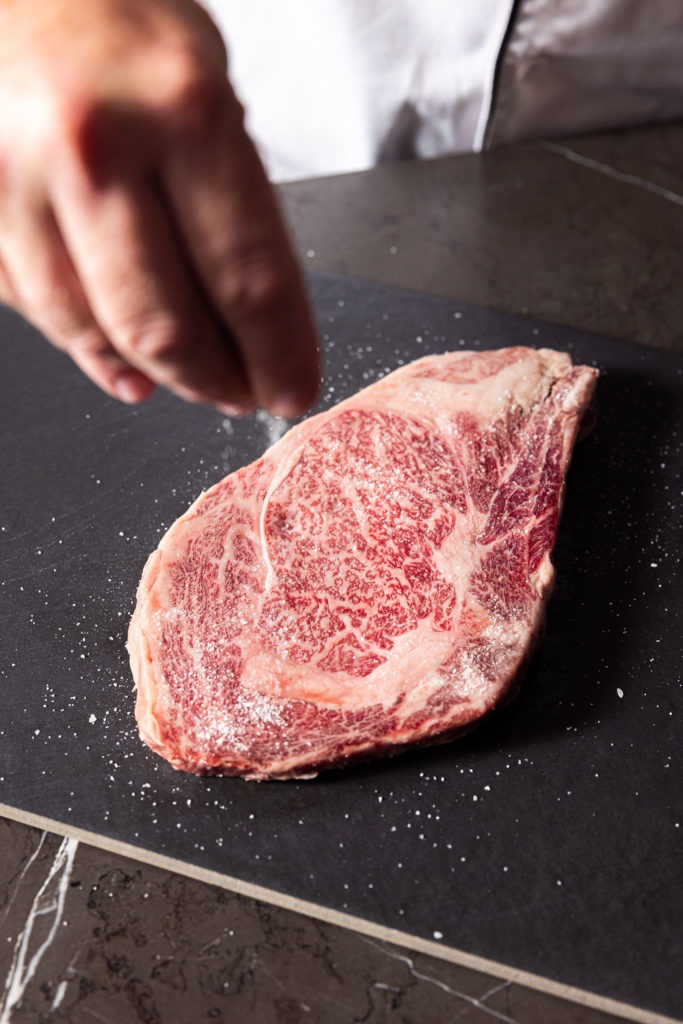
But when should that salt be added? It’s best to salt your wagyu steak pretty well in advance of cooking. Give it a good seasoning with kosher salt and put it back in the fridge for at least an hour—up to overnight—while the meat absorbs the salt and releases excess moisture near the surface. Doing it in advance, instead of right when you’re about to cook, will deepen the flavor and it will help you get a better sear. Pat off the surface of the meat with a napkin before you sear it to take up any moisture that has migrated to the surface. Now you have a steak that is well and deeply seasoned, and you have less moisture to cook off before your steak starts to brown. Excellent.
The fat in wagyu beef melts at a lower temperature than other—lesser—beef fat. As soon as you touch a wagyu steak the fat starts to melt. Because we want to retain as much of that luscious, rich fat within the meat, we find it best to cook the steaks from cold rather than letting them come up to room temp.
Yes, yes. We know. So many sites say to let the steak warm up a bit. But really, if you do that you’re going to drop fat into the pan even faster than you would if with a cold steak. Not only will you be losing precious fat, but it’s also just good thermal sense to have the inside of the steak cold if we want it to end up being rare or medium rare. Why would we want to start with meat that is 40°F closer to done?!? We want a center that is barely cooked, and getting it warm before it goes into the pan isn’t going to make that happen. Keep your steak just above freezing temp until it’s ready to hit the pan.
The only thing a beautiful wagyu steak lacks is a brown, meaty crust, and for that, we need a good, hard sear. The hotter we are about to sear the surface, the less we’ll overcook the inside of the steak, so we need a hot pan. We need our pan to be at least 425°F (218°C) to get the sear we want.
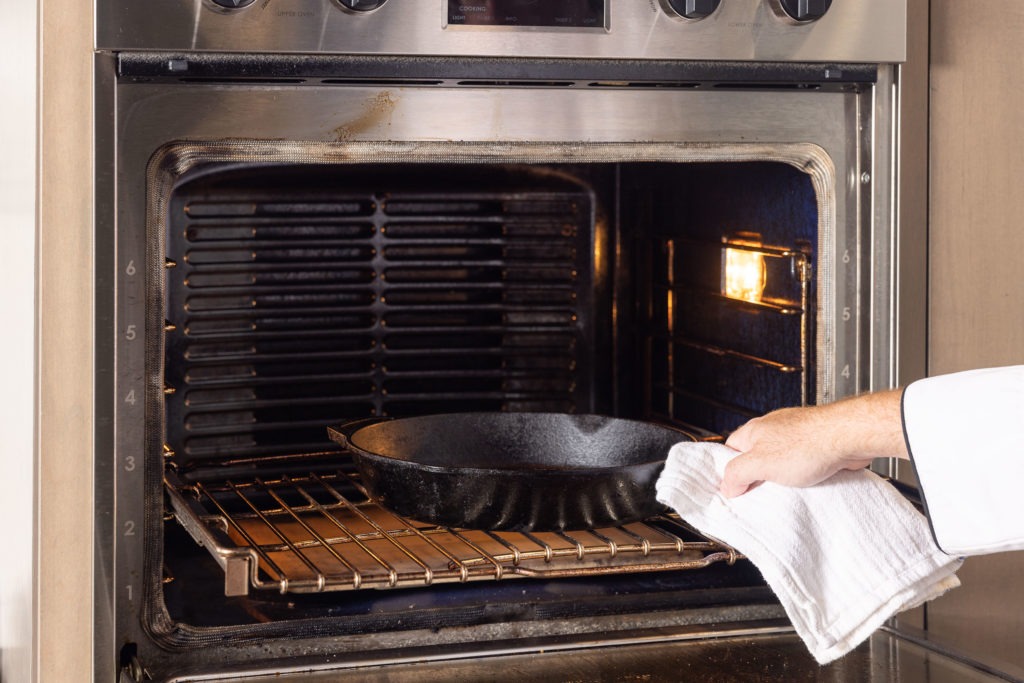
To make sure the pan is evenly heated, with fewer hot or cold spots, put a cast iron pan in the oven and heat the oven to 425°F (218°C). Allow the pan to sit in that hot oven for a few minutes, then move it onto the stove and turn the heat on to medium-high. Keeping heat pumping into the pan is important to get a good sear. Before you introduce a steak to the pan, check its temperature with a good IR thermometer to make sure it’s hot enough.
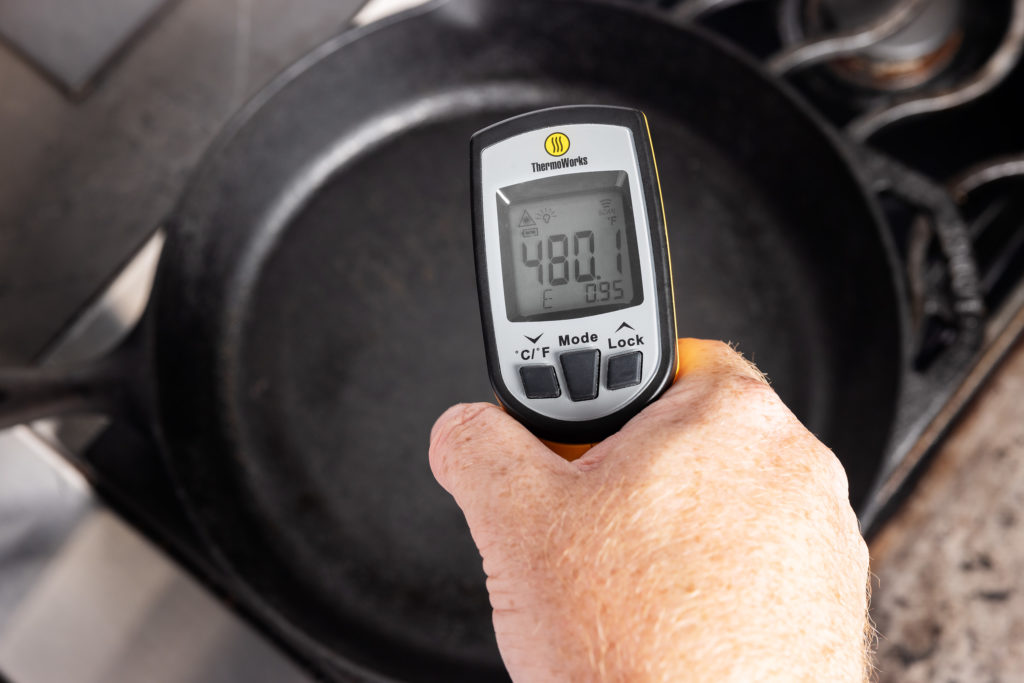
Our steak was rather thin, and that means it’s in special danger of overcooking or of cooking unevenly. To combat that tendency, we flipped our steak often, about every 60 seconds. By pumping heat into the surface of the steak and then flipping it, we create the crust we want, without forcing more heat down into the meat. This is much like cooking on a rotisserie and is a stove-top version of the “just keep flipping” method.
What is Japanese Wagyu beef?
Wagyu beef comes from wagyu cattle, and—right off—we can note that “Japanese wagyu” is redundant, because “wagyu” literally means “Japanese cattle.” Wagyu beef comes from four breeds of cattle developed in Japan over the last hundred years, the most common being Kuroge Washu, also called the Japanese Black. All the wagyu breeds are descended from native breeds that were crossbred—sometimes with European cattle breeds. Now, all wagyu cattle in Japan are registered with a central office and their breeding is strictly monitored to prevent unwanted crossbreeds as well as problematic inbreeding.
What we often mean when we say “wagyu beef” is actually “Kobe-style beef.” In the region of Kobe, the cattlemen created rules for how those cattle could be bred and raised, all of which resulted in supremely fatty, extremely well-marbled meat. Kobe beef wasn’t exported until 2012, but it is now available through specialty retailers like themeatery.com, from whom we got our steak.
The Japanese beef grading system has a top grade of A5, which reflects marbling as well as other factors. An A5 wagyu steak is the top of the line. But even among A5 steaks, there are differences. Wagyu beef also receives a BMS score, which is a further measure of fat content and marbling. A steak that is BMS 12 is nearly white with fat. We used a steak that was BMS 9 for this cook and it was incredible. One can only imagine what a BMS 11 or 12 would be like!
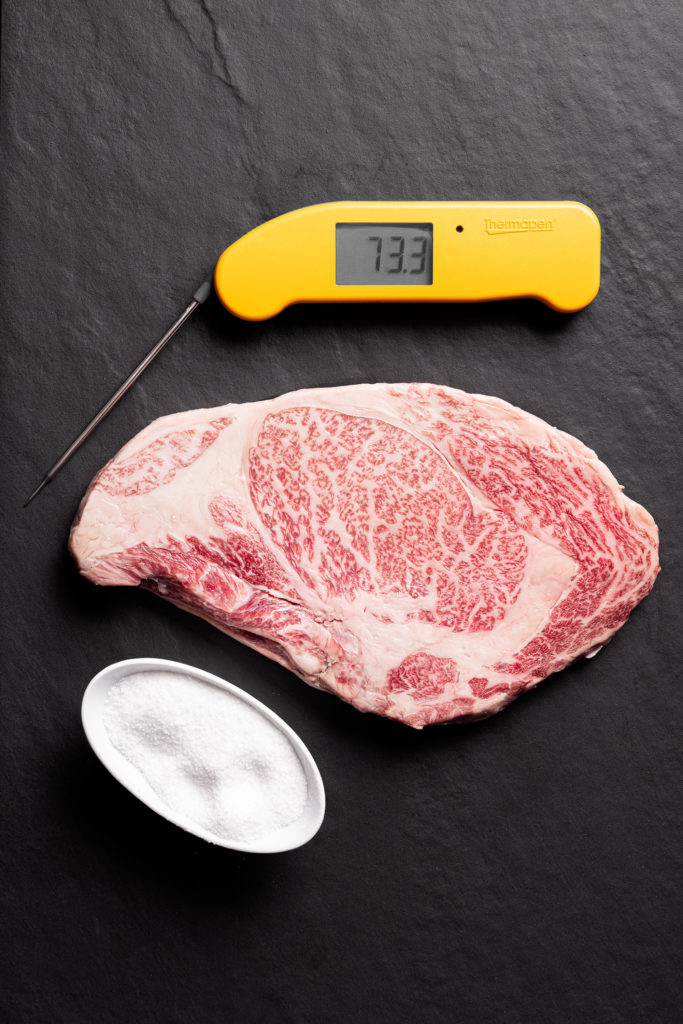
Now, faking marbling like that just isn’t possible. But just to be on the safe side, real wagyu comes with a certificate identifying the cow from which it came, including the cow’s unique nose print. Does the certificate make the steak better? No. Does it show a dedication to care and effort that is reflected in the quality of the meat? Yes.
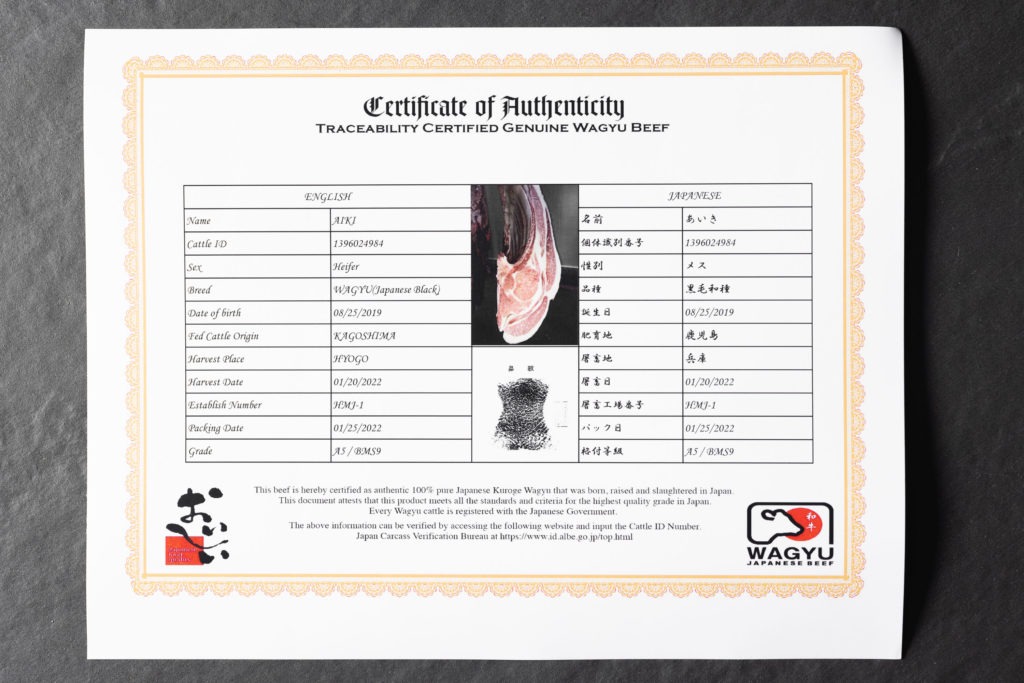
How to Cook a Wagyu Ribeye at Home (Perfect Every Time)
FAQ
How to cook a 2 Wagyu steak?
- Season several hours before cooking with salt and pepper.
- Cook on medium heat and remove from direct heat after 2-3 minutes on each side.
- Remove from heat and let rest after reaching desired temperature (145 degrees F for medium rare, 160 degrees F for medium)
How is Wagyu beef best cooked?
Most culinary pros agree that Wagyu is best when cooked rare to medium-rare. This heats the steak enough to start breaking down the marbling, basting the steak in its own highly tasty fat, but avoids overcooking meat that demands a light touch.
What is the best way to cook Wagyu burgers?
Try the two-zone grilling method; one zone should be searing the patties over high heat for about a minute on each side, then finish them on the cooler side …
Is it better to grill or pan-fry wagyu steak?
Always cook wagyu in a pan the way you’ve mentioned or with rendered butter. NEVER cook wagyu on a grill unless you want to waste it’s beautiful and flavorful (and expensive) fat. Use a cast iron pan if you have it.
